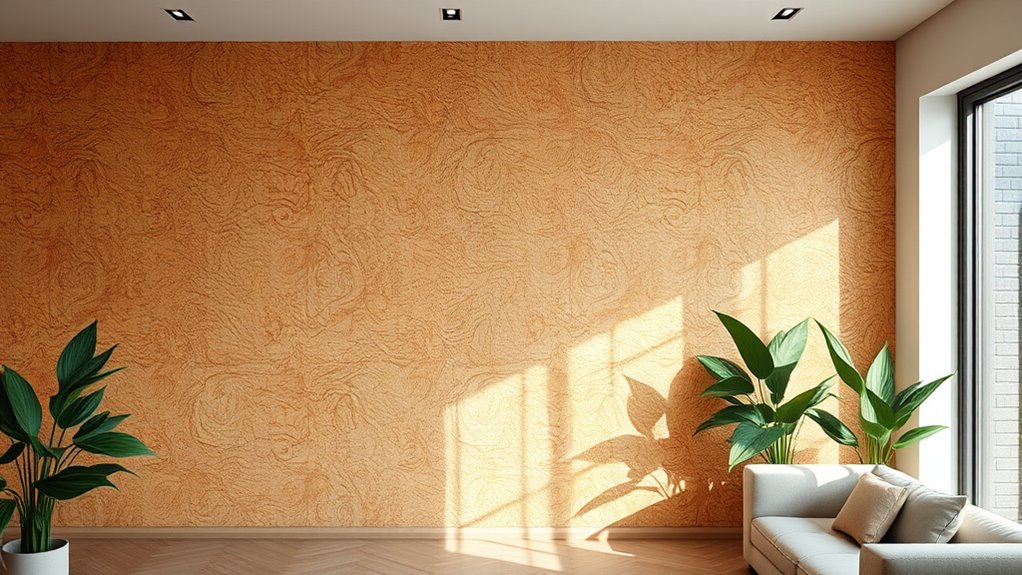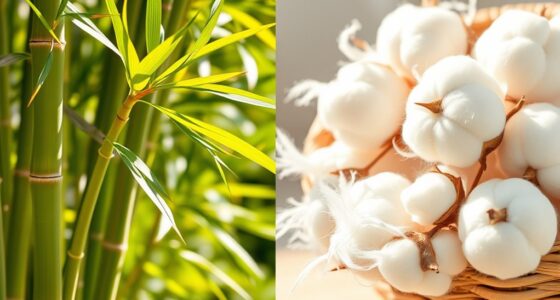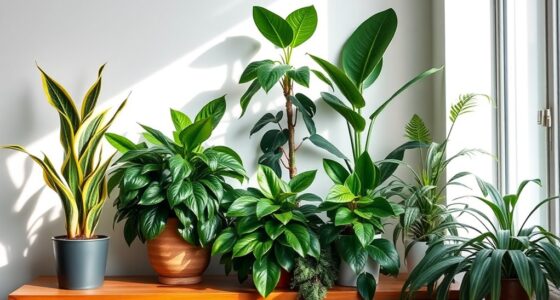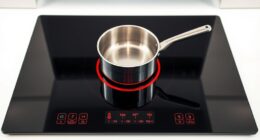Cork wall panels are quickly becoming a top choice for green décor because they’re natural, renewable, and biodegradable. Harvested without harming cork oak trees, they absorb more CO2 than traditional forestry methods and support eco certifications like FSC and LEED. They enhance indoor comfort with insulation, improve air quality, and add stylish textures to any space. If you explore further, you’ll discover how cork panels combine sustainability with versatility for modern interiors.
Key Takeaways
- Made from natural, renewable cork oak bark harvested sustainably, supporting responsible forestry and circular economy principles.
- Provides superior thermal and acoustic insulation, enhancing energy efficiency and indoor comfort sustainably.
- Biodegradable and recyclable, reducing waste and contributing to eco-friendly building standards like LEED.
- Resistant to mold, pests, and damage, ensuring durable, low-maintenance, eco-conscious interior solutions.
- Versatile in design, mimicking natural materials and supporting biophilic, sustainable décor styles.
The Environmental Advantages of Cork Wall Panels
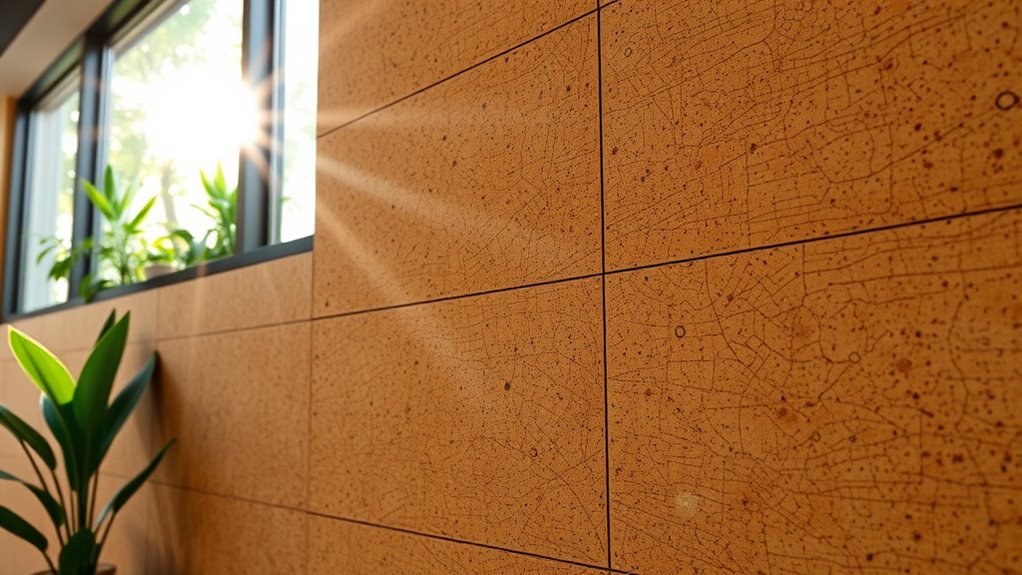
Cork wall panels offer significant environmental benefits by being a sustainable and eco-friendly building material. Made from the natural bark of cork oak trees, they can be harvested every 9-12 years without harming the tree, supporting ecological balance. As a biodegradable material, cork reduces waste and promotes circular economy practices through its recyclability. Cork harvesting also absorbs up to five times more CO2 than other forestry methods, actively helping combat climate change. Additionally, cork wall panels provide excellent thermal insulation, which helps maintain indoor temperatures and reduces energy use. This natural insulation lowers your building’s carbon footprint and enhances sustainability. Moreover, monitoring credit card statements is vital in today’s digital age to prevent fraud and protect your investment. Certified by organizations like FSC, cork ensures responsible sourcing, making it a smart choice for eco-conscious construction and design. Incorporating cork panels also encourages sustainable design principles, aligning with broader efforts to reduce environmental impact. Using cork in interior decor can inspire eco-friendly choices and promote a greener lifestyle. Furthermore, the renewable harvesting process supports ecological balance and biodiversity conservation. Additionally, cork’s unique properties make it a versatile material suitable for various types of interior decor, fostering innovative and sustainable design solutions.
Enhancing Indoor Comfort and Air Quality With Cork
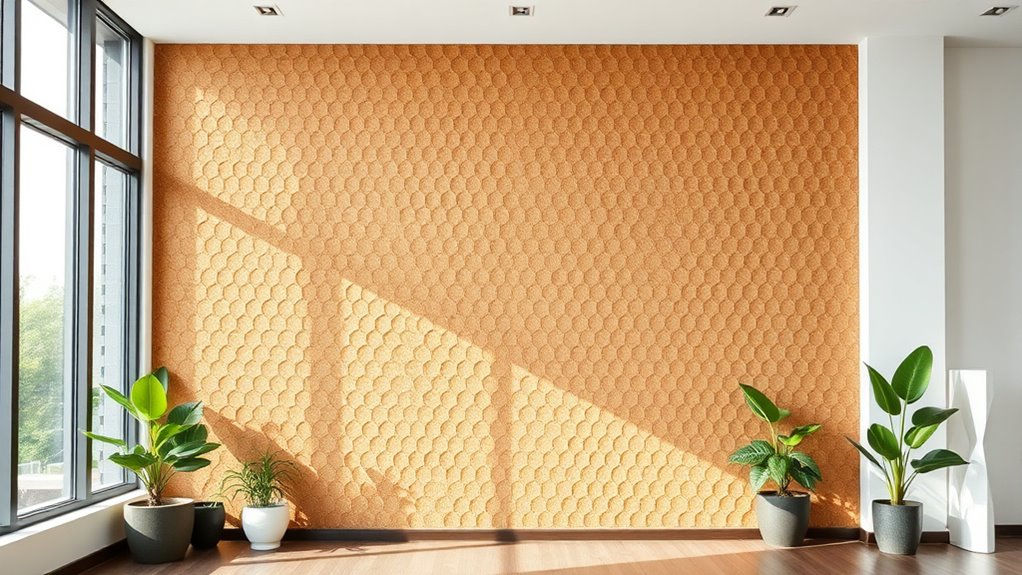
Because of its natural properties, cork wall panels actively improve indoor comfort and air quality. Cork is hypoallergenic and resistant to mold, mildew, and dust mites, which helps keep indoor air cleaner. Its porous cellular structure provides excellent thermal insulation, maintaining stable temperatures and reducing the need for heating or cooling. Cork’s sound-absorbing qualities also minimize noise transmission, creating a quieter, more comfortable environment. Additionally, cork is biodegradable and emits no toxic gases or VOCs, promoting healthier indoor spaces. Its natural elasticity absorbs impacts and vibrations, enhancing overall comfort and reducing stress on structures. By incorporating cork wall panels, you can enjoy a healthier, more comfortable indoor environment while supporting sustainable décor choices.
Sustainability Certifications and Eco-Friendly Attributes

Sustainable sourcing and eco-friendly attributes are key benefits of choosing cork wall panels. Cork is often made from FSC-certified materials, ensuring responsible harvesting that supports forest conservation. Using residual cork minimizes waste and aligns with circular economy principles, making each panel a sustainable choice. Cork’s natural biodegradability and renewability further enhance its eco-friendly attributes, providing an environmentally responsible alternative to synthetic wall coverings. Certifications like LEED recognize cork as a sustainable material that contributes to green building standards. Additionally, cork absorbs carbon dioxide during its growth, making it a carbon-negative material that actively supports climate change mitigation. By selecting cork wall panels, you’re embracing a product that combines verified sustainability certifications with eco-friendly features, helping you create healthier, greener indoor environments. Color accuracy and contrast ratio play crucial roles in achieving a visually appealing and environmentally conscious interior design. Incorporating cork panels also supports sustainable development, further reinforcing their role in eco-friendly architecture.
Design Versatility and Aesthetic Appeal of Cork Walls

Cork wall panels offer a wide range of design options, from natural textures to vibrant colors, so you can create a look that reflects your style. Their seamless integration into various interior themes makes them a versatile choice for both modern and traditional spaces. With customization possibilities, cork walls add warmth and visual interest while blending effortlessly with your overall design. Additionally, cork’s natural insulation properties can help improve energy efficiency in your home or office. Beyond aesthetics, cork’s sustainable material qualities make it an environmentally friendly choice for eco-conscious consumers. Furthermore, understanding the local regulations surrounding sustainable materials can help ensure your décor choices align with eco-friendly standards. The biodegradable nature of cork also contributes to its reputation as an eco-friendly option that reduces environmental impact.
Diverse Design Options
Cork wall panels offer a striking range of design options that can elevate any interior space. Their vivid colors, rich textures, and natural patterns enhance aesthetics and mimic materials like stone or wood, including cork oak. This versatility allows you to customize your environment seamlessly, whether aiming for a modern, rustic, or organic look. The lightweight cork wall makes installation simple, letting you create unique configurations and patterns without major structural changes. The cellular honeycomb structure adds visual depth and warmth, giving your space a tactile and inviting feel. With a variety of finishes and veneer options, cork wall panels support personalized design schemes while maintaining eco-friendly benefits. Here are some ways they elevate your décor:
- Mimic natural materials with rich textures
- Fit diverse interior styles effortlessly
- Enable creative, customizable patterns
- Support sustainable design by choosing eco-friendly materials that support green décor initiatives. Additionally, their security features make them a safe choice for both residential and commercial spaces. Integrating cork wall panels can also complement farmhouse aesthetics, adding a rustic charm while remaining environmentally conscious. Incorporating cork panels can also contribute to sound insulation, enhancing acoustic comfort in various settings.
Seamless Interior Integration
Because of their natural textures and earthy tones, cork wall panels effortlessly blend with a wide range of interior styles, from sleek modern spaces to cozy rustic environments. The organic appearance of natural cork adds warmth and depth, making it easy to integrate into various interior designs. Their versatility allows you to customize with vivid colors and rich textures, creating striking feature walls or subtle accents. The lightweight, modular design simplifies installation and reconfiguration, giving you flexibility in your layout choices. Cork’s ability to complement materials like metal, wood, and marble enhances its seamless integration into diverse settings. Additionally, sustainable building materials like cork are gaining popularity for their eco-friendly benefits and natural appeal. The inherent insulating properties of cork panels help improve energy efficiency and acoustic performance within interior spaces. Their surface finishes and veneers expand aesthetic possibilities, making them a practical and stylish choice for elevating your interior design with natural elegance. Incorporating cork panels can also promote environmental sustainability, aligning your interior choices with eco-conscious values. Utilizing cork can also contribute to creating a more healthy indoor environment by reducing indoor pollutants and maintaining better air quality.
Practical Benefits: Insulation, Durability, and Maintenance
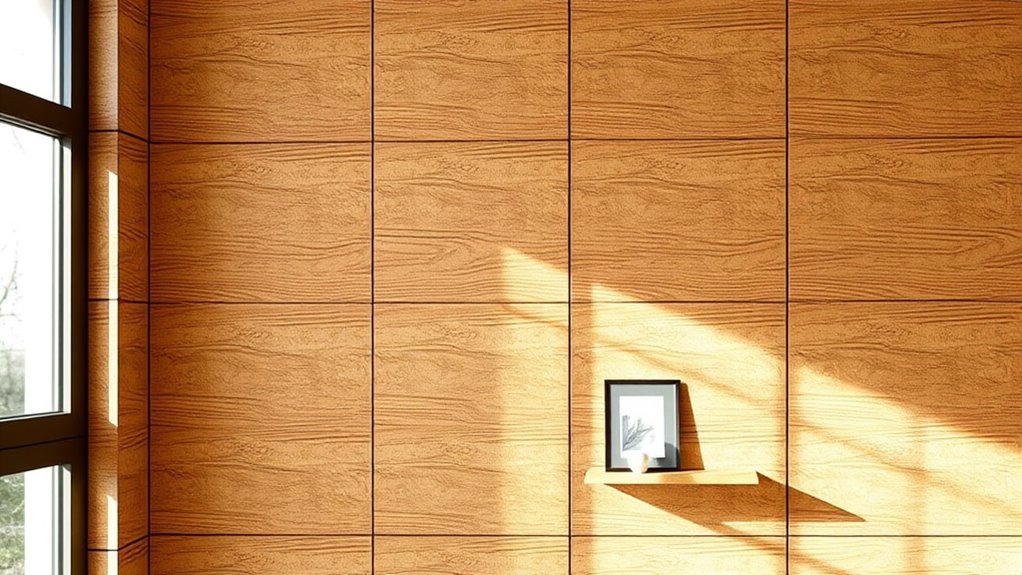
Cork wall panels offer excellent thermal insulation, helping you save on energy and stay comfortable year-round. Their honeycomb structure makes them tough and resistant to impacts, mold, and mildew, so they last for decades. Plus, they’re easy to maintain with just simple dusting or gentle cleaning, making them a practical choice for busy spaces.
Superior Thermal Insulation
Thanks to its cellular honeycomb structure, cork wall panels provide exceptional thermal insulation by trapping air and reducing heat transfer. This natural design enhances their insulation properties, helping you maintain consistent indoor temperatures. As a result, you’ll notice lower energy bills and increased comfort. Cork’s insulating capabilities make it an excellent choice for sustainable décor, similar to cork flooring’s energy-saving benefits. Here’s what sets cork apart:
- Air-trapping honeycomb cells that reduce heat flow
- Suberin content that resists moisture, mold, and mildew
- Elasticity and compressibility for long-lasting insulation performance
Long-lasting Structural Integrity
With their natural resilience and elasticity, cork wall panels are built to last for decades, maintaining their structural integrity over time. Thanks to cork’s cellular structure, these panels resist cracking, warping, and damage from impacts or shifts. Their excellent thermal and acoustic insulation properties reduce the need for frequent repairs, supporting long-lasting durability. Cork’s resistance to mold, mildew, and insects ensures they stay durable in various indoor environments with minimal maintenance. Additionally, their fire-retardant qualities mean they burn slowly and emit no toxic gases, enhancing safety and durability during fire exposure. The ease of installation and inherent compressibility allow cork panels to adapt to structural movements, preserving their integrity over the years. Overall, cork provides a reliable, long-lasting solution for sustainable wall décor.
Easy Upkeep and Cleaning
Maintaining cork wall panels is simple and requires minimal effort. Their resistance to moisture and mold makes cleaning straightforward, reducing the need for harsh chemicals. With easy upkeep, you just need to dust or vacuum regularly to keep them looking fresh. When deeper cleaning is necessary, a damp cloth with a mild cleaner is enough to maintain their appearance and hygiene. The durability of cork panels also means they won’t chip or crack easily, even with routine cleaning. Plus, their insulating properties help control indoor temperatures, which can lessen dust buildup. Overall, cork wall panels offer practical benefits like resistance to moisture and low maintenance, making them an ideal choice for sustainable and easy-to-care-for décor.
Key Benefits:
- Minimal dusting or vacuuming
- Resistance to mold and mildew
- Damp wiping with mild cleaner
Innovations and Trends in Cork Wall Applications

Innovations in cork wall technology are transforming interior design by offering sustainable, functional, and aesthetically versatile solutions. These panels now enhance natural light diffusion while providing superior acoustic and thermal insulation, boosting indoor comfort and energy efficiency. The future of sustainable building practices is supported by LEED-certified, biodegradable cork panels that align with eco-friendly goals. Their natural antimicrobial and mold-resistant qualities help maintain healthier indoor environments. Modern cork wall designs come in a variety of textures, colors, and finishes, allowing you to customize spaces effortlessly. As biophilic interior design gains popularity, cork wall panels serve as a natural, eco-conscious choice that promotes well-being. These innovations are pushing cork toward becoming a leading material in sustainable, stylish, and functional décor.
Comparing Cork Walls to Other Sustainable Décor Options

Compared to other sustainable décor options, cork wall panels stand out for their renewability and biodegradability, as they are harvested sustainably from cork oak trees without harming the environment. The benefits of cork include no toxic gas emissions, improved indoor air quality, and superior thermal and acoustic insulation. Unlike synthetic options, cork panels are resistant to mold, mildew, and pests, making them durable and low-maintenance. They also support eco certifications like LEED, highlighting their sustainability. When comparing cork walls to other eco-friendly materials, consider:
- Renewable source from cork trees without damage
- Natural insulation properties reducing energy costs
- Biodegradable and eco-friendly lifecycle
These benefits position cork wall panels as a compelling, sustainable décor choice.
Frequently Asked Questions
What Is One Downside of Cork Flooring?
One downside of cork flooring is its vulnerability to damage from pet nails, especially if you have cats or dogs. You might notice scratches or dents over time, which can make the surface look worn out. Additionally, cork can fade or discolor if exposed to prolonged direct sunlight. It’s also more susceptible to stains from spills if you don’t clean them up quickly. So, consider these factors before choosing cork flooring for your home.
Is Cork Environmentally Friendly?
Imagine a green heart in your home, beating with nature’s own rhythm—that’s cork. You’ll find it environmentally friendly because it’s harvested sustainably from cork oak trees, which absorb more CO2 than other trees. It’s biodegradable, recyclable, and produced responsibly. When you choose cork wall panels, you support a healthier planet, enjoy toxin-free air, and embrace a material that’s as gentle on Earth as it is beautiful in your space.
Is Cork Flooring a Good Green Design Alternative?
Cork flooring proves to be an excellent green design choice. You benefit from its renewable, biodegradable materials, and its natural insulation helps lower energy costs. It’s durable, low-maintenance, and emits no toxic gases, making your space healthier. Plus, cork’s shock absorption adds comfort. Choosing cork flooring supports sustainable forestry and reduces environmental impact, giving you a stylish, eco-friendly option that aligns with your commitment to green living.
Is Cork Flooring Eco-Friendly?
You’re curious if cork flooring is truly eco-friendly, and the answer might surprise you. Cork flooring, made from sustainably harvested cork oak bark, regenerates every 9-12 years without harming the tree, making it a renewable resource. It’s biodegradable, recyclable, and produces minimal chemicals during manufacturing. Plus, it offers natural insulation and air quality benefits. With these eco-advantages, cork flooring stands out as an environmentally conscious choice for your home.
Conclusion
If you choose cork wall panels, you’re embracing a sustainable option that reduces carbon footprint—cork harvesting is renewable and doesn’t harm trees. Did you know cork panels can improve indoor air quality by filtering pollutants? With their natural insulation and stylish versatility, they’re shaping the future of eco-friendly décor. So, why not make your space greener and more comfortable? Cork might just be the sustainable choice you’ve been searching for.
